For our first official kayaking trip, we decided on Link River and Alice Lake. Because they were familiar and close to home, we thought they would be a not-so-terrifying option for our first time. A hop, skip and a jump from Port Alice, Link River is a very short shallow rocky river joining Victoria Lake and Alice Lake. Of the two lakes, Alice Lake is smaller. Not only that, but, according to local folklore, Victoria Lake is rumoured to be “bottomless” (or close to it) and we thought that it might be a bit too adventurous for beginning kayakers. The Link River campsite, with the river to the south joining into Alice Lake to the east, has very tall coniferous trees and a forest floor covered with ferns, giving it all the brooding exoticness of an Emily Carr painting.
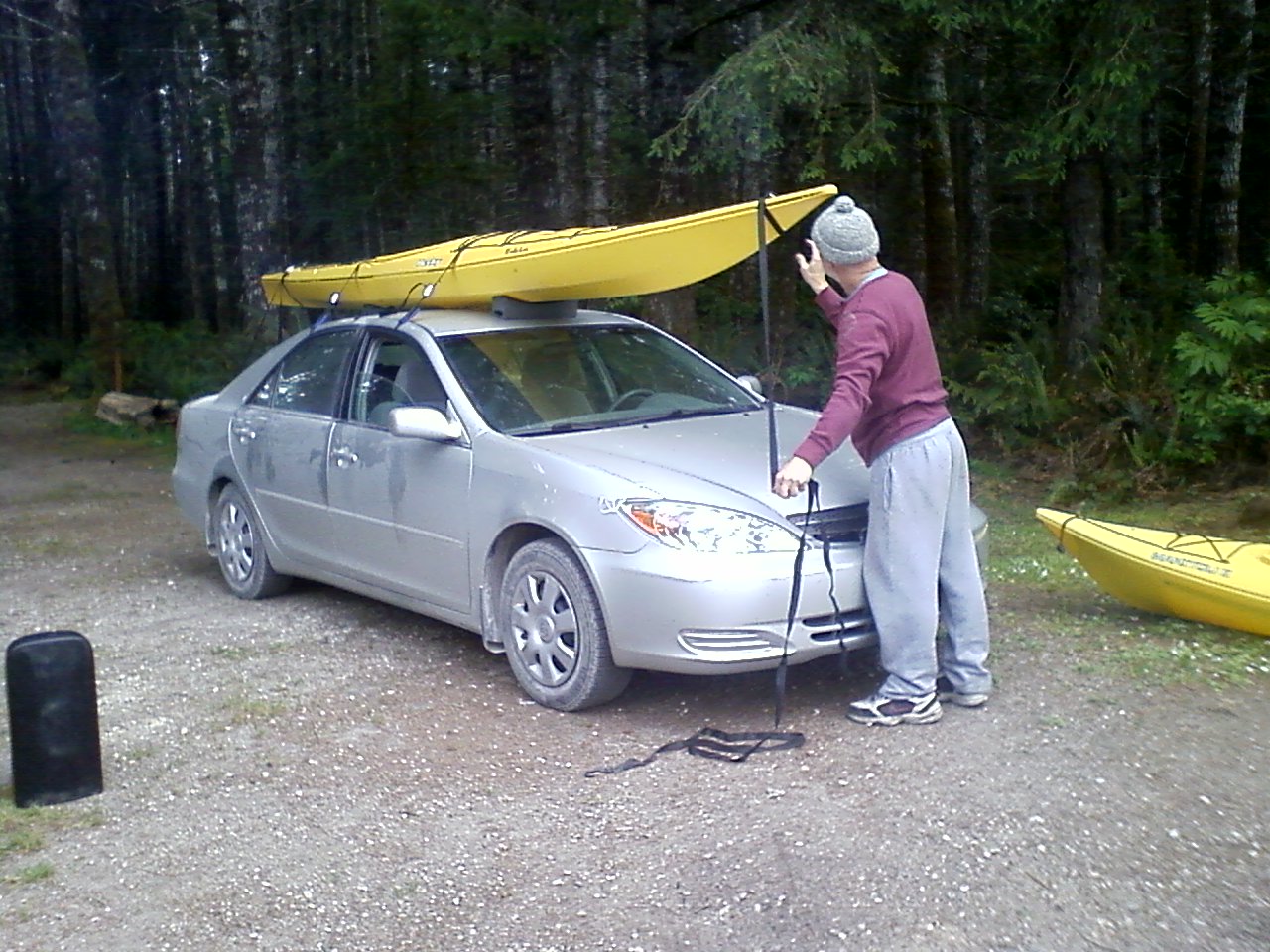 Unloading the Eskia.
Unloading the Eskia.
May 28, 2015
We were concerned about the campsite filling up so we went down to set up camp on Thursday. James would stay there Thursday night with Chloe and I would go back home to do my lunch supervisor job on Friday and come after. The first hurdle we had to face when kayaking for the first time was how to transport our kayaks. We didn’t have the money to buy fancy dancy kayak carriers, so we were forced to improvise. A while ago we bought some foam supports at Canadian Tire that were suggested to us by a fellow kayaker. They are basically a couple of pieces of foam that you stick on the top of your vehicle for the kayak to sit on. Once it is all strapped in place, the kayak is fairly secure. They are cheap, are not a permanent solution, but work in a pinch. We didn’t think they would work for the truck (but we eventually found out, they did), so we were trying to come up with an alternative.
James found a real estate sandwich board sign among the junk in my carport. I was possibly saving it for selling my book at craft fairs, but hadn’t made a final decision about it yet. I found it at our transfer station that is coined the “Port Alice Walmart.” The transfer station has a covered give and take area, making it a great place to “shop” in Port Alice. Especially during the time that Port Alice was a rich mill town, you could find amazing stuff there! Not only is most of my furniture acquired from the transfer station, but many of the materials for renovating my house--drywall mud, paint, doors, etc,--has been retrieved from there. And because I have a small house, I also had to leave a lot of stuff there to make room for the new stuff I found.
James anchored the sandwich board to the end of the truck box with a ratchet strap, so it could work as an extension beyond the tailgate. After putting a couple of the foam supports onto the sandwich board, we lifted the Manitou onto it. It was sticking way beyond our truck box, so we slanted it to the passenger’s side. We didn’t want to knick anybody while taking any of the sharp curves on the winding Port Alice road. We wound one strap around the bridge between the two cockpits and hinged it to the tie-down cleats near the front of the box. I got an idea to lasso the back of the kayak with two straps and tie them to the cleats at each side of the back of the box. James tied the nose to a cleat at the front of the truck box with super heavy string. He secured the foamies with duct tape and, with that-- though the Manitou didn’t look very classy--it was definitely secure. We then loaded Eskia onto the car, loaded up our camping supplies and headed down to Link River.
To get to Link River from any direction, you have to travel the Port Alice road, Highway 30, until you see very noticeable signs that say “Link River.” That’s hard to miss. Once you head east on the Link River road, it gets a little tricky, especially if you are not used to driving the back roads of BC. You basically have to travel down logging roads to get there--but the forest is full of logging roads. Be careful where you turn and which fork you take. If you take the wrong road you can end up halfway to Dimension X or some other tricky place like a narrow road on the top of a mountain with no room to turn around and go down (I will tell about that experience a little later). Link River, however, is pretty tame as forest back roads in the area go. There are three forks in the road, but they all have “official” district signs pointing to Link River. There are also a lot of home-made signs to help you out as well. It’s hard for anything to go wrong. Link River is a short drive from the highway, so if you find yourself driving for hours and hours and not getting anywhere, you took the wrong turn (we have stories like that too).
At this point I think I should take some time to inform you about another hazard of logging roads: logging trucks! Logging trucks have the right of way. That means if you run into one on a one lane dirt road you have to make room for it…even if it means driving into the ditch, that is, if there is one! Sometimes there isn’t one, and you and your vehicle will become a pancake! Sometimes they will stop if they can; but, the g-forces created by their loads make it difficult. Because loggers maintain banker’s hours, a good way to avoid them is to travel after 6 pm on the week days or on weekends. We have forestry companies to thank for the roads that lead us to our back woods adventures, so we have to respect their jurisdiction over them. They are not so much of a concern going to Link River. There is a lot of tourist traffic on the Link River road and the logging companies seem to make adjustments for that. Wherever you go in the back woods, keep your eyes and your ears open, stay close to your side of the road, and keep a look out for escape routes.
When we arrived at Link River there was practically no one around, so we had our pick of campsites. It was almost a problem because we took a long time checking out all the sites--which were all very beautiful—and deciding on which to use. We finally settled on the place with a bunch of large sculptural stumps, one of which had steps carved into it. After setting up camp, I left James and Chloe behind and went home with James’ car. Not thinking too clearly, we traded keys so that he had my truck keys and I had his car keys. I didn’t realize it at the time that I was giving him my house keys! I went all the way home, drove into my carport, seeing my cat, Mr. Magoo, waiting at the door for his chow, and I couldn’t get in! I just skipped the swearing and beating myself up part. I apologized to Mr. Magoo, turned around and went back all the way to Link River.
By the time I got back to Link River, I discovered James had moved the campsite. He said it had too much northern exposure and was too windy. With the stumps too, it felt kind of eerie and especially damp. When I finally got home, Mr. Magoo had given up waiting and was on another cat adventure. I spent the evening thoroughly watering my garden, which included my vegetable garden in the back, the hydrangea garden in the front and all the potted herbs and tomatoes on my balcony. On a hot dry day, watering all my gardens can take two hours or more. When I came here from Alberta, I assumed that it rained here all the time and that I wouldn’t need my garden hose. Luckily, I brought it anyway. In Port Alice especially, we can get a good share of hot sunny weather in the summer. I like to call Port Alice the “California of the North Island.” After seeing James and me pack up our vehicles for camping the day before, my neighbours looked at me oddly. I had the feeling that they thought James and I had a fight. When they asked, “how was kayaking?” I explained that we had just set up camp and that I would go there after work tomorrow. Even when I told them that, I had the feeling they didn’t really believe me.
I got caught up in doing this and that, leaving a note and food out for the cat sitter, and doing some last minute watering. By the time I made it to Link River, it was quite late in the afternoon. Taking advantage of very calm water, James and Chloe had already kayaked across the lake to the Pinch Creek campsite. Chloe was cool as a cucumber on her first official kayak journey, burying herself under her blankets in her little Chihuahua cockpit and napping as James paddled across the lake. By the time I arrived, the water was choppy. We debated about whether or not we should take it on. We decided to just take a short trip, which ended up being not that short.
This wasn’t our absolute first time on kayaks. When we were camping at Rupert Arm early in the spring, we borrowed another camper’s double kayak for a good long day. For our second time, we took turns trying out our Eskia on Neroutsos Inlet the day we bought it. That day, however, it was windy and miserable and raining a bit. One thing I will always remember about that day was when James tried to cast off on the kayak still on his feet and trying to casually slip into the cockpit as he was drifting. We now know that when you cast off in a kayak, your butt should be firmly inside! I think I tried to mention something about that; but, in the short space of time it took to ignore me, James’ face ended up in the water! It was April and the water must have been very cold to fall into!
Had we not known any better, we probably would have said this was a pretty hard paddle. These days, we tend to avoid kayaking when the water is that rough, if we can. The waves were nearly a foot high, and we could only manage by cutting straight through them. Luckily, because James grew up and lived on the Island most of his life, he knew that much. I threw myself into the paddling job at hand, and found myself ending up way ahead of James. He wasn’t expecting me to be such a vigorous paddler, perhaps being that I was an old lady and all! Actually, neither was I! He kept wondering when I would tire out, as I seemed to go on and on like the Energizer bunny. We then got into a conversation about “sprinters” vs. “marathoners.” James has always been fast on his feet; he’s the sprinter. Even today, he can run a lot faster than many thirty year olds. I, on the other hand, am not fast, but I can go at a constant steady pace for long distances. I won ribbons for long distance running in high school and I participated in a couple of 200 km MS bike marathons in Alberta when I was in my thirties. James introduced me to the idea of “fast twitch” and “slow twitch” muscles. People who have fast twitch muscles, like James, can produce a lot of power in a short space of time. My muscles likely twitch more slowly, which allow me to go on longer at a steady pace. I’ve always been fair to middling when it comes to sports and track and field. We realized, however, that if I had been introduced to paddling young enough and had had the right opportunities, I might have been able to dream of going into the Olympics. Instead, I am now a geriatric paddler writing a blog! Can’t complain. Paddling is paddling.
I’m much more graceful at getting in and out of the kayak now, but, then, I struggled to get out. James always had to help me those first times and I probably moved in ways that were very unladylike. For James, it must have seemed very much like helping an ox out of a kayak! Getting in and out of the kayak is a skill that requires some practice. The most common way to do it is to straddle the kayak, lean forward and engage your stomach muscles to get lift. Part of my awkwardness was also due to the fact that I was a prairie chicken, unfamiliar with boating in general. James was graceful at exiting the kayak from the start.
It was early evening when we came back, so it was time to start a campfire and have supper. When it comes to making a campfire and setting up a camp kitchen, I have to sit back, snuggle with Chloe and let James have full control. You might call him an over-aged boy scout. As a child he was very involved in boy scouts and even went on camping trips in the winter in deep snow with his troops. He still embodies those old boy scout values of nobility and honourability. I’ve always had a lot of upper body strength and have been able to lift practically anything any guy my size can lift. Though I’m in my fifties and some of my strength has waned, I can still lift a heavy object if I have to. Being with James, however, he will quickly jump in and lift heavier objects before I do like I was some petite helpless damsel in distress! When there is something both of us can and should lift together, he won’t give me much of a chance to help him and will move it single-handedly. I find this state of affairs quite amusing. I’m actually getting a little bit lazy these days, though “lazy” is not really in my DNA. I will enjoy this situation as much as I can before he gets any the wiser.
James may have been lord and master of the campfire and the camp kitchen, but I provided the entertainment. After supper, I brought out some cards and poker chips and we played until it got dark and James cleaned me out of all my poker chips. Because I spent a few seasons working in a mountain lookout with my son, I have a lot of board and card games. I am now a firm believer in the positive social value of games. Too much of our entertainment these days is people sitting in front of a screen like zombies and tuning one another out. With board and card games there is more social interaction and mental stimulation. It’s also a great way to get to know someone you’ve just met too. On one of our first dates I asked James for a Scrabble game and I’m sure he thought it was very peculiar. He didn’t really see the light until sometime during the winter of 2015, when I reintroduced Scrabble during a power failure. Sometime after that we started playing Scrabble quite regularly and one day, like a big kid, he spouted, “This is fun.”
May 29, 2015
We headed south on very calm waters in the morning, James in the Eskia and I in the Manitou with Chloe. After we launched, Chloe realized her daddy was in the other kayak and was a little upset. She whined and whined and tried to reach out of her cockpit towards him. We used firm and commanding voices to make her stay put. It wasn’t long before Chloe turned around under her fleece blanket and, protected from any rogue raindrops and splashing water, went down for her nap. We headed south toward the Benson River. An image that has stuck in my mind is of James gliding into a cove with cattails and giggling like a little boy. One can go just about anywhere with a kayak! From there we came to the mouth of the Benson River and went up a little bit until it our bottoms were scraping rocks. After a rest break on a rocky island, we headed to Pinch Creek at the southeast end of Alice Lake.
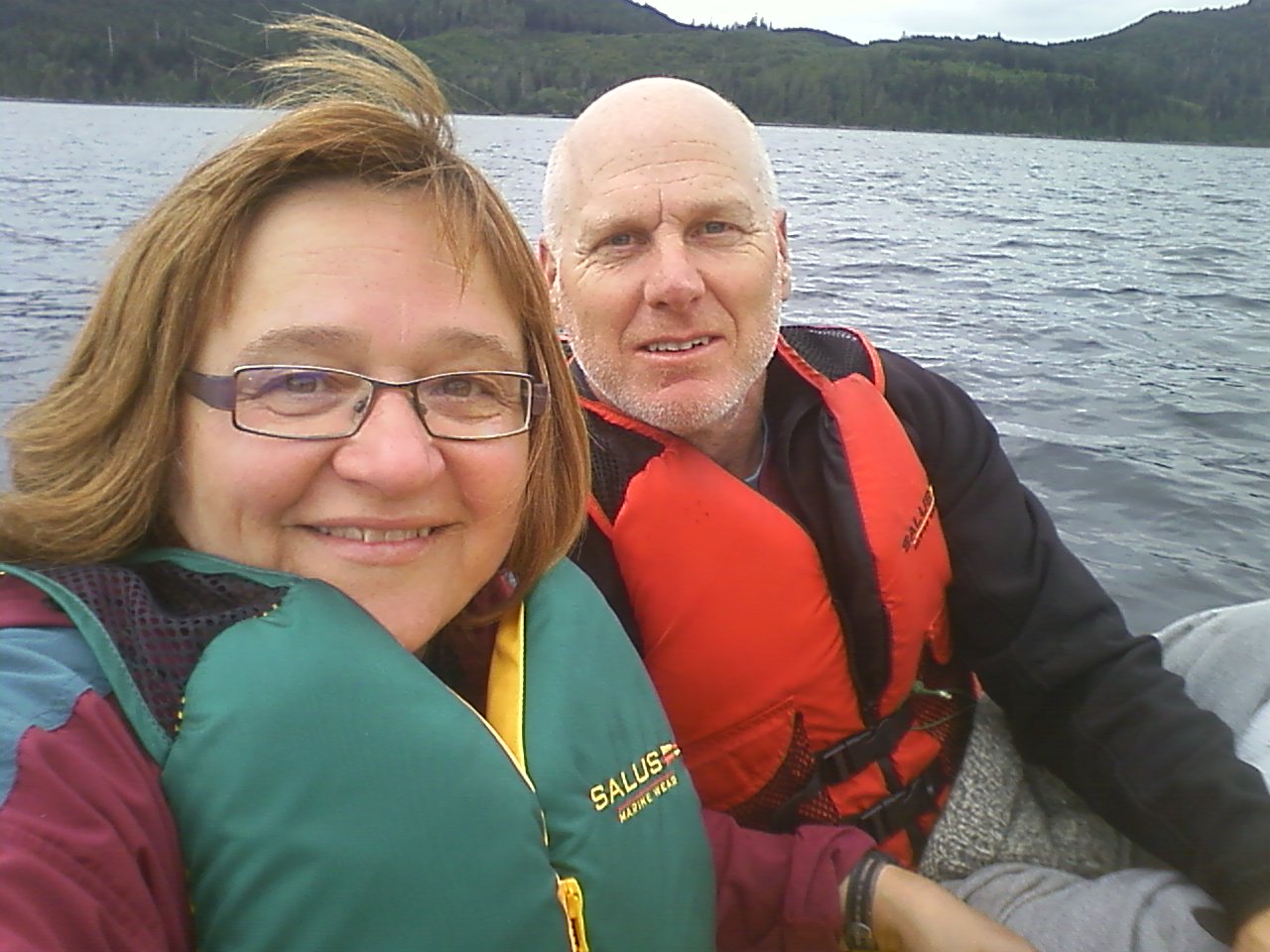 Two fifty-something first timers.
Two fifty-something first timers.
 Chloe in the cattails.
Chloe in the cattails.
Arriving at the Pinch Creek campsite, we came upon a ghastly sight if you have a fire-fighting background like I do! There was not a single person in sight, but there was a campfire smoldering away in a very high to extreme forest fire hazard! Granted, it was amongst a bunch of boulders; however, it still had potential for disaster. It seems there are two important things that people don’t realize when they leave a smoldering fire: the weather is fickle and dirt burns! It may have been calm that day, but a calm day can turn into a hurricane, re-enlivening the fire and sending it into the forest canopy. Even an increase of 30 or 40 km per hour, or a few degrees drop in relative humidity can significantly change fire behaviour. As for dirt: the forest floor is composed of a lot of flammable things like dried leaves and twigs and the far reaching roots of nearby trees. If some heat from a campfire reaches a root, it basically becomes a coaxial cable for combustion. Sometime later a nearby tree can suddenly explode into flames seemingly for no reason! Another little known fact about fires that people should know about is that if you have any heat at all, even two tiny molecules bumping together to produce half a degree of heat, it is still technically a fire! It might die, or, it may grow. Because of this, fires can burn without producing smoke for days, weeks, months, even years! I’m definitely not kidding! A fire can remain in the ground over the winter and come up the next spring! A coal seam fire can burn for several years, even decades! When some of that coal heat finds a crack in the ground and forest fuels, it produces smoke and reveals itself. I’ve heard of stories of coal seam fires burning for a hundred years! I checked out the internet and apparently there is a coal seam fire at Burning Mountain in Australia that has been burning for an estimated 6000 years!
James and I decided we would put out the fire, but have our lunch first. We found a nice stump to sit on as we munched away on cheese and rice cakes, grapes and non-alcoholic beer. As we ate, Chloe checked out the surroundings for any messages left by other critters, and then left a few herself. She joined us for her doggie snack and to beg for some of ours. We later perused the treed part of the campsite.
If Link River campsite has the brooding exoticness of an Emily Carr painting, the Pinch Creek site has it twice as much! It is not as accessible as Link River. One has to travel a little further down a logging road to get to it, or get to it by boat. It seemed to have extra ferns, extra matted old man’s hairs hanging from the branches and less traces of human existence. It was like a forgotten room in the back of an old house that is built up with cobwebs and dust. And just like that forgotten room in the back of an old house, Pinch Creek seemed to have more than its fair share of spirits! This was definitely the domain of beings who wanted to stay away from people! After making use of the facilities in the form of a very beaten up, run down, leaning and very smelly outhouse that hadn’t been serviced probably in thirty years (It was so decrepit--it was kind of a novelty), we headed for the shore and our fire-fighting job. We started by filling up our beer cans with lake water and pouring it on the fire. That wasn’t getting anywhere very fast. James then had an epiphany to use our bilge pumps. He would figure that out, being that he is a pipe-fitter and all! Even though the pumps carried a lot more water, it still took quite a lot of trips, perhaps a dozen or more, to put out that seemingly “itsy bitsy” smoldering campfire.
Having done a good 10 kilometres in 2 hours, we were done kayaking for the day and had a whole bunch of day left. The long weekend crowds that were predicted did not transpire. There weren’t many people around to mingle with and there was no tube to watch, so we buried our noses in our books. James was reading Absolute Power by James Baldacci. I was reading James A. Michener’s story of the Gold Rush called, Journey, and it was really pulling me a long. Even though I am a writer, I’m not a fast reader and I can get easily distracted if a story isn’t interesting enough for me. When I read, it is usually one chapter at a time, or even a couple of pages at a time. I wasn’t having that problem with Journey. I was really enjoyably lost in it, getting through more than half the book in a day.
Even though Journey was a lot of fun, it had some “plot holes” that bothered me. I think that Michener has not spent a lot of time in the wilderness, as he seems to have missed out some crucial details of wilderness living…mosquitoes for one! He mentions them in one area in the Yukon, but they should have been everywhere. When I was working in fire towers in Lac La Biche (not far from Athabasca Landing, a major launching point of the Gold Rush), I had to wear a sufficient amount of armor to protect myself from them when I went for walks in the evening. Not only did I wear clothing to cover every bit of bare skin and my head, I had to douse myself with copious amounts of mosquito repellent on my face and head and even over my clothes! Even with that, sometimes I had to wear mosquito netting and that didn’t even work! With all this protection, the mosquito problem was only less, not eliminated…reduced to bearable! If not properly protected, a person in the bush could easily die from mosquito and bug bites alone.
Another thing that bothered me was the lack of animal encounters. The main characters spent years in the wilderness getting to their Gold Rush. You cannot spend that much time out in the wilderness without having a significant amount of interaction with animals, not just with larger creatures like bear and moose, but also smaller ones like squirrels, beavers, ground hogs, etc. Not only that, but they would have had to listen to the wolves and the coyotes howling on many a night, and it would have a certain effect on them. His description made the north seem more like a void with trees. I tend to see the forest as a bustling city with animals in it, with every square inch of territory claimed by some kind of critter, big or small. The forest is private property, but, instead of being marked with stakes and fence lines, it is marked with pee. Perhaps animals back then made themselves more invisible because they were at a high risk of becoming someone’s lunch. Nevertheless, I find his depiction of the north to be very one-dimensional, as if the north is simply a back drop for human activity, rather than a mystical and alive world onto itself.
This is why I think it is so unfortunate that First Nations communities had to suffer through the residential school system. The residential schools dismembered centuries of knowledge that the First Nations people had about the “engine of life” that is the forest. The fact that so much information has been lost in the cultural genocide might prove disadvantageous for all of us sometime in the future.
For example: lately, I’ve been getting into ethno botany. I’ve been educating myself about herbs and foods that grow locally that First Nations people harvested back in the day. Now, when I walk past forest vegetation, I see it very differently than I used to. In the fall, James and I joined family for a gathering at Rupert Arm. As soon as I got there I couldn’t help but notice a bunch of red clover for my arthritis, rose hips for colds and sea asparagus for making sea asparagus pickles and I set about picking. I’m sure everybody thought I was a little odd, but they got used to it. What others might see as just vegetation, I now see as a grocery and health food store! This is very ironic, as many of the Gold Rush trekkers in Michener’s book suffered from scurvy and died from it. Little did these scurvy sufferers realize that they were surrounded with the cure: spruce and pine needles are loaded with vitamin C! They could have made a tea from them or ate them straight. This is what likely happened in real life too: Gold Rushers died from scurvy while being literally surrounded by the antidote! Anyone in the gold rush era who attempted to forage a connection with First Nations people probably had a leg up, and were the ones who survived and thrived.
I was struck with a bit of nostalgia when the book mentioned my home town “Athabasca Landing” or just “Athabasca.” I always knew it had a close association with the Gold Rush. I was surprised to discover just how much! I was amazed at how so many footsteps from afar went through the sleepy little community that I grew up in.
I was taken aback by the fact that Michener mentioned a passenger train between Calgary and Edmonton. I had never heard such a thing, although many bemoan the fact that there isn’t one between the two major cities in the present day. There’s been a lot of talk about a high speed raised rail line between Calgary and Edmonton when I was living there, but so far, nothing has happened. You would think if any two cities need a train between them, it would be Edmonton and Calgary. They are the two main cities in the province, are relatively the same size, and have a lot of flat ground between them. I checked it out and it looks like there actually was a passenger train between Calgary and Edmonton during the Gold Rush. It looks as if there were several attempts to maintain train service along that route afterward, which were curtailed by the First World War and then by the popularity of the airplane and automobile. One would think that, with global warming and infrastructure development being prominent issues of the day, perhaps an elevated solar and/or wind powered high speed train service between Edmonton and Calgary might finally come into fruition?
We kept reading until it got dark, then we pulled out our flashlights and read some more. After retiring to out tent, the books still didn’t get put away. As Chloe snored away under a pile of blankets at our feet, we kept on reading for over an hour more before finally calling it quits on our day long readathon.
May 30, 2015
On Sunday we headed north, crossing Alice Lake on a diagonal. James kept complaining I was racing too far ahead. When I slowed down, it made way for plenty of conversation about life. We kept paddling for the longest time, but our destination did not seem to get too close too fast. We were dealing with a lot of water, apparently, a lot more than we thought! Finally, when the distance between our boats and the distant shore was finally bridged, we came upon the first of the hidden treasures we would come upon that day: a huge graveyard of driftwood! Along the whole shore, from the east side of the lake to the point, which was maybe a good kilometre, there was driftwood everywhere. Some of it was massive! I could have spent hours and hours enjoying all the smooth voluminous shapes with strange twisty roots that looked like fallen imaginary monsters. I also had the urge to save some of these pieces to make lamps and end tables, but there was no room on the kayaks! I supposed we could have towed, but I was more interested in kayaking on further. Chloe was snooping in all the nooks and crannies that served as protection for small critters and their stashes. A couple of times she walked along some driftwood and found herself up too high up to get down on the ground and we had to provide her with some assistance.
We discovered some of the driftwood was carved with chain saws. I started putting two and two together and realized this would be a good place for fire-fighters to “day base.” When the fire hazard gets up there, a helicopter full of fire fighters flies out to a spot in the bush so they can be closer to a sensitive area should a fire break out. This was probably an ideal spot to hang out for the day for fire-fighters trying to cope with the boredom of day-basing, hence why some of them got out their power saws and started trying to make art, or something, out of the driftwood. We went a little further and discovered this was a well used base. My presumption proved correct when, deep in the driftwood, we found the bare bones of a camp kitchen, about twenty by twenty feet square, constructed out of stumps. It had a roof with some roofing paper on top, and counters with plywood tops.
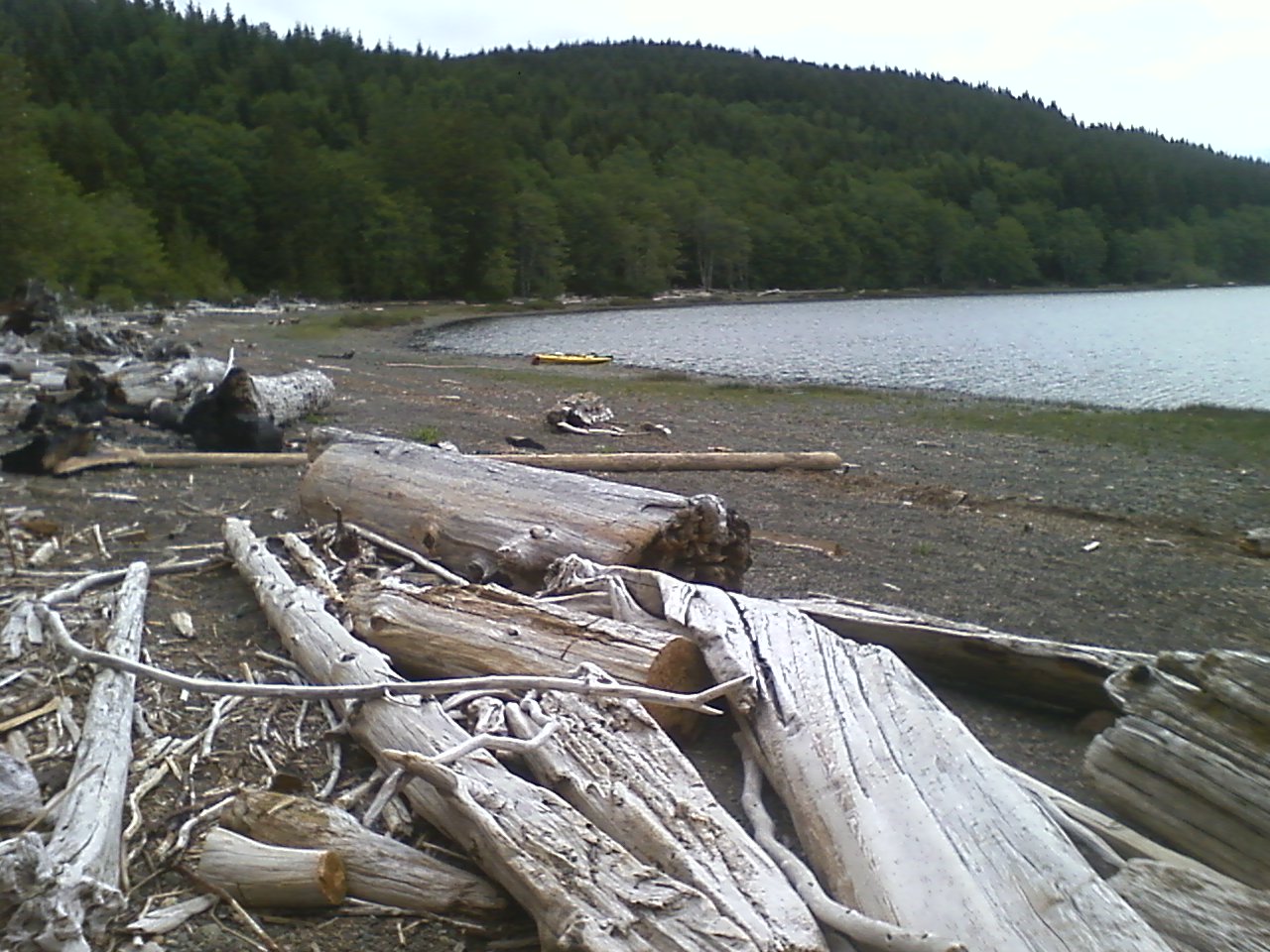 Driftwood Beach.
Driftwood Beach.
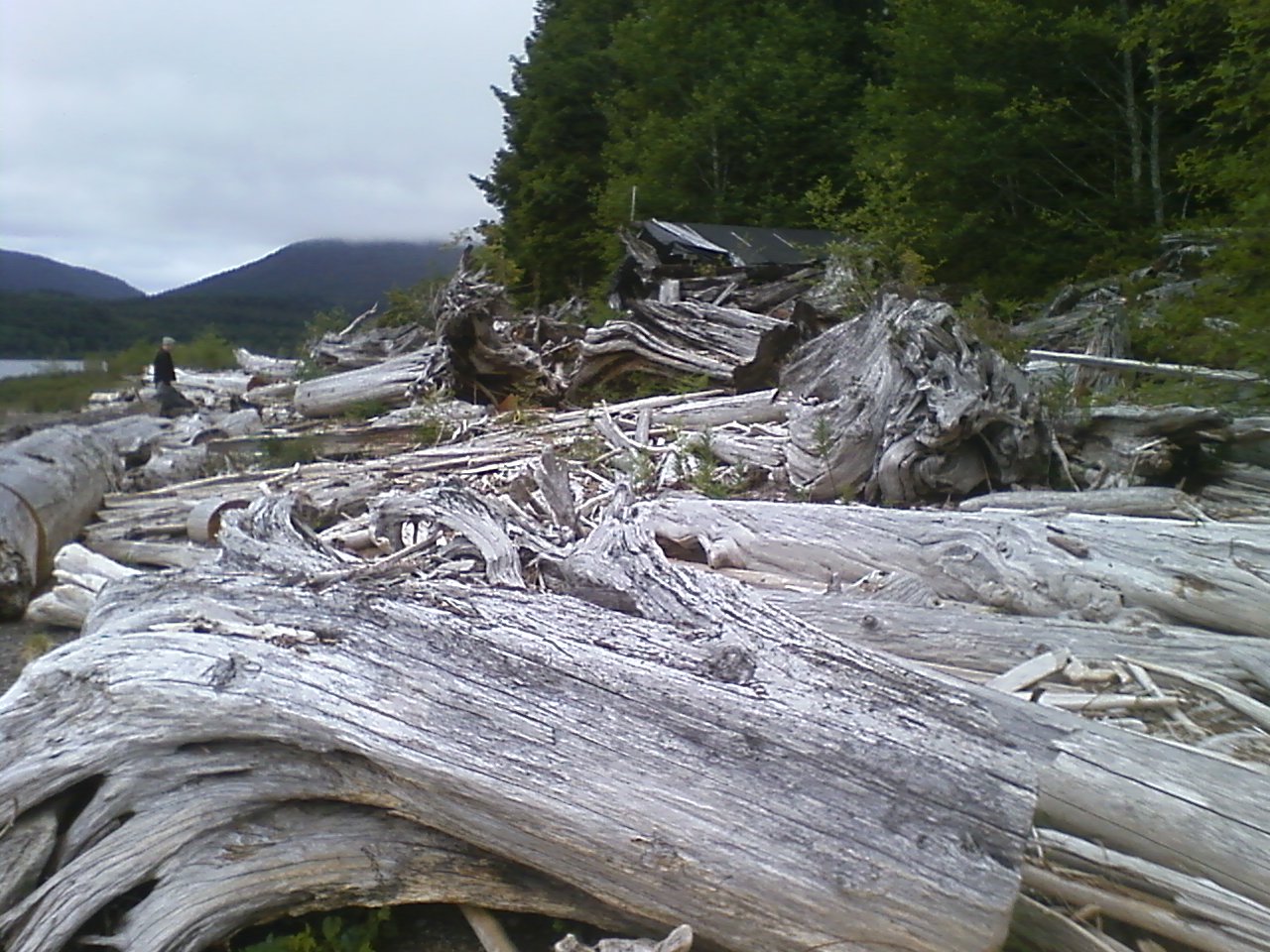 The camp kitchen.
The camp kitchen.
All we had for taking pictures of the driftwood was my flip phone. It was too bad, because taking photos of sculptural objects, I’d say, is my specialty. James had a Galaxy 3 for taking pictures, but, for some reason, those photos went missing. For this Link River trip, all we have are flip phone photos. Many apologies for the low resolution images. That will change. We later upgraded our picture taking equipment to a higher definition camera phone, and are now looking to upgrade even more with a water resistant SLR camera. When we get it, I think we are going to have make a special trip out to Driftwood Beach to take pictures.
After a snack and some pictures among the stumps, we took off around the point, hoping to get close to the island to the north. That also seemed to take a long time too, even though it looked like it was quite close at first. As we rounded the island we noticed something odd on the rocky shore of the lake. It was a log tied to a tree beside a fire pit. Going around the rocky outcrop we saw a weatherworn dock. I wanted to keep going but James was more curious. Still feeling a little awkward in the kayak, I thought it would be hard to get into our kayaks from that dock. I suggested to James to go ahead and check things out. He came back saying “you’ve got to see this.” We docked our kayaks, tying them to any lose rope we could find on the ramshackle pier.
I wondered what could have possibly got him so excited. After I pulled myself up the steep narrow path through the Salal, there it was in all its rugged glory: a cabin! James told me he had heard of cabins like this interspersed through the bush. They are built on crown land, so no one actually owns them even though they have had a lot of effort and expense put into building them. This cabin was built with two by fours, plywood and cedar planks on a foundation of logs embedded into the ground. It had a covered front porch and a leaning outhouse a ways away. There was a sign on the door written in pencil, welcoming us in. We were told we could make use of the cabin and the items inside, but to keep it cleaner than when we arrived and replace anything we used. Inside there was a wood stove, a picnic table and lighting in the form of candles and kerosene lamps. There were roughshod counters with Rubbermaid totes underneath. One was filled with pots, pans, dishes and utensils, and another was filled with board games. There was an old sofa from the seventies or eighties and a guest book that was filled to the brim with comments made by its visitors that went back as far as 1995. It was quite possible that the people who originally built this cabin hadn’t seen it in a good long while. There were two levels of beds built into the wall with a ladder for getting up to the higher one. There was an emergency supply of toilet paper hanging from the middle of the ceiling on a rope, to be kept from being devoured by rats and mice.
James and I sat down and had our snack and read through some of the guest book. Since it was at the end, we vowed that the next time we came, we’d bring a new one. We wanted to stay there and spend the night, but I had lunch supervisor duty the next day. We followed a trail down to the fire pit we saw from the water, imagining what it would be like to be sitting around a campfire under the stars. We proclaimed it very lovely and definitely a future destination.
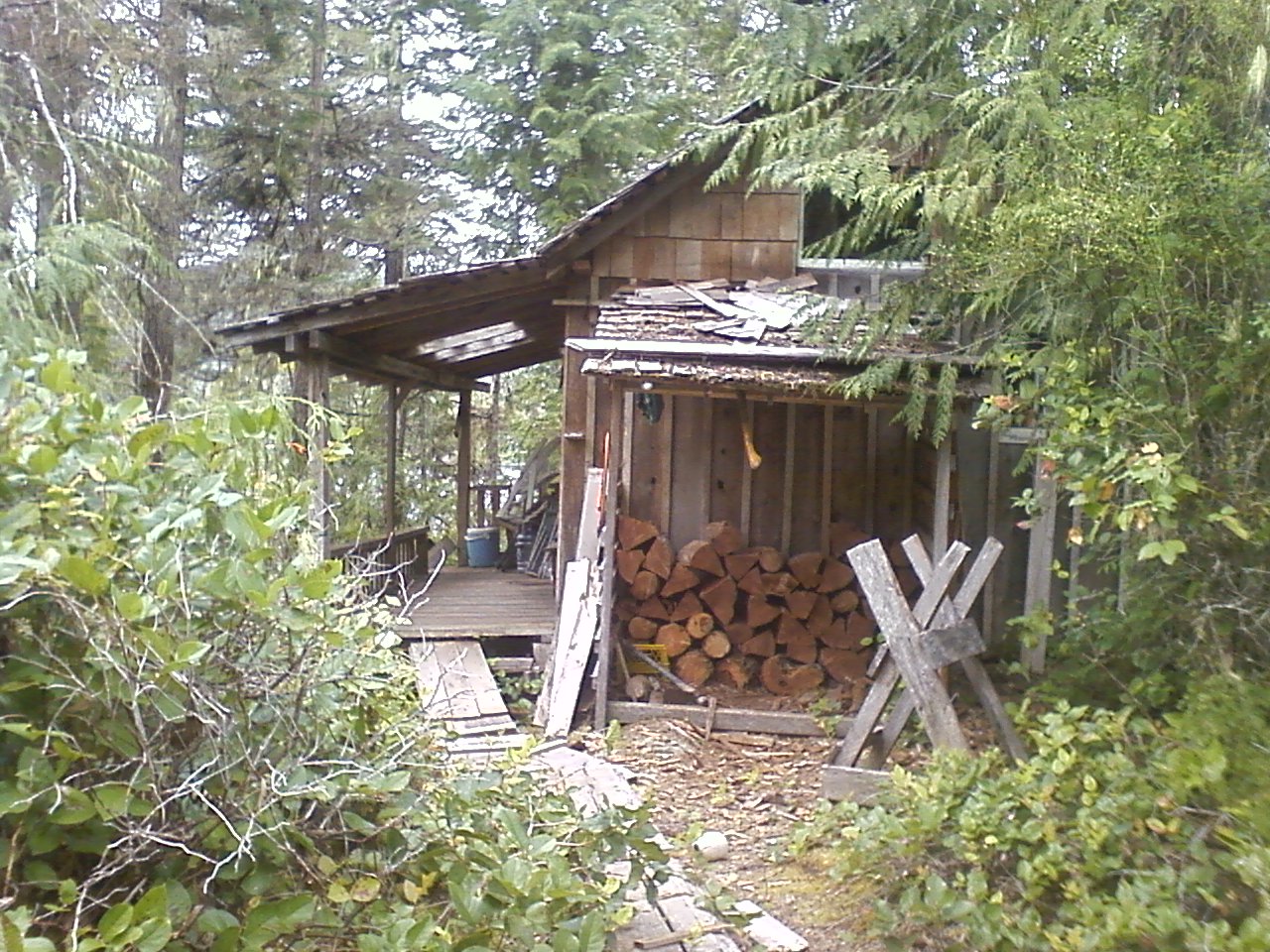 The cabin.
The cabin.
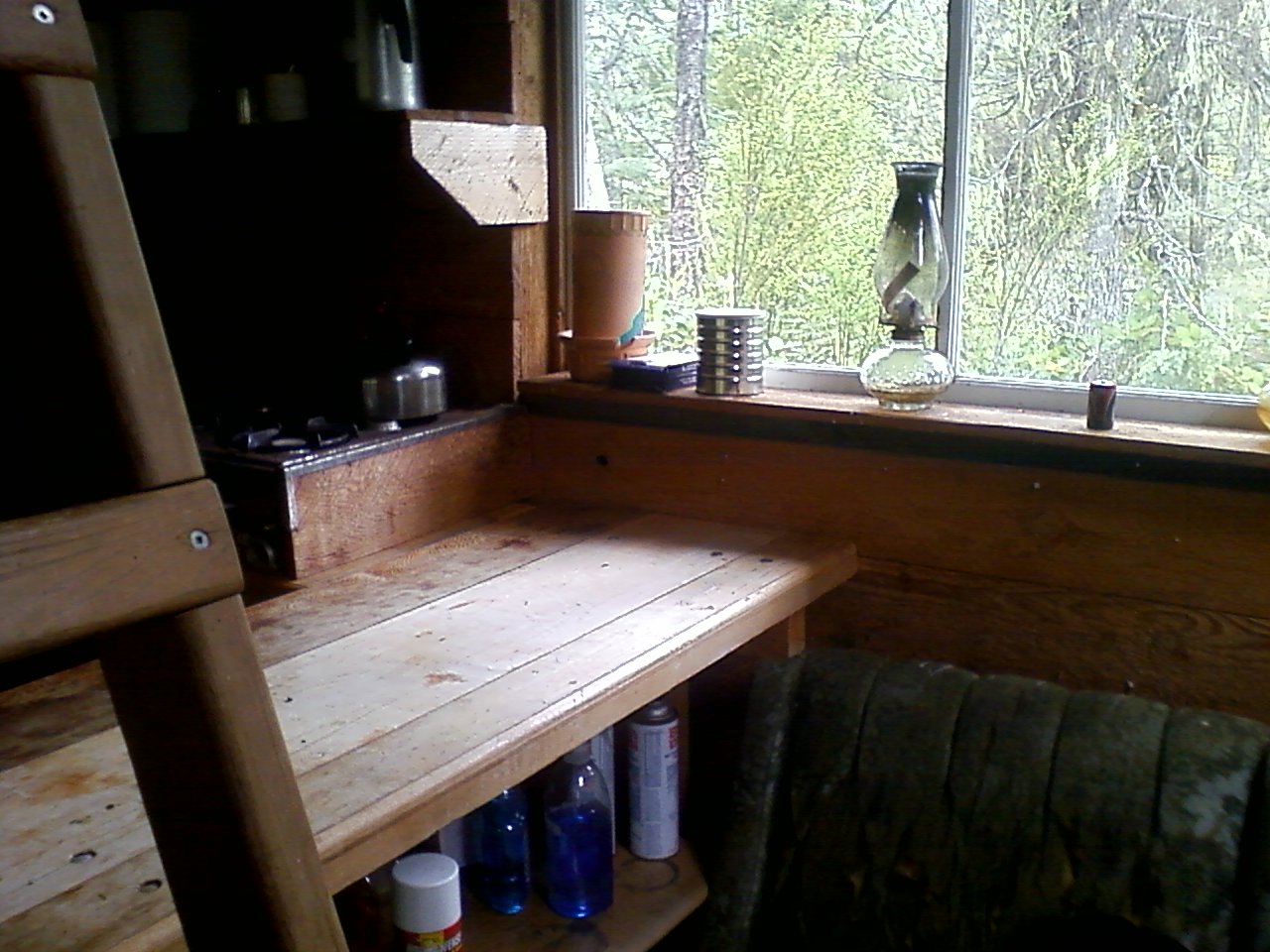 Inside the cabin.
Inside the cabin.
We didn’t have too much difficulty getting into our boats from the dock. You just have to walk on your hands and slip your keister down. We paddled around the island. I got disoriented and James had to straighten me out and make me go in the right direction. Thank God he stopped me or we might have ended up going down Marble River! Going back, with the sun coming out, it made the water a very intense blue. With the Merry Widow in the background another lovely hue of blue, we took numerous pictures of it with James’ phone which are now lost forever! After spending so much time out-paddling James, at the last stretch going home, he out-paddled me. He left me in the dust (or the splash), with my paddling getting continually weaker and weaker. He got his second wind and my wind was out! We estimated that we kayaked a total of 12 kilometres that day. For the whole weekend I kayaked 25 kilometres and James did close to 30! Not bad for first timers!
So an over-aged boy scout, a retired Smokey the Bear and a kayaking Chihuahua had their first official kayaking outing! I’m surprised by how our little neighbourhood recreational retreat turned out to be such an adventure. Stay tuned folks! There will be many more adventures to come!
 It's a kayaking dog's life.
It's a kayaking dog's life.